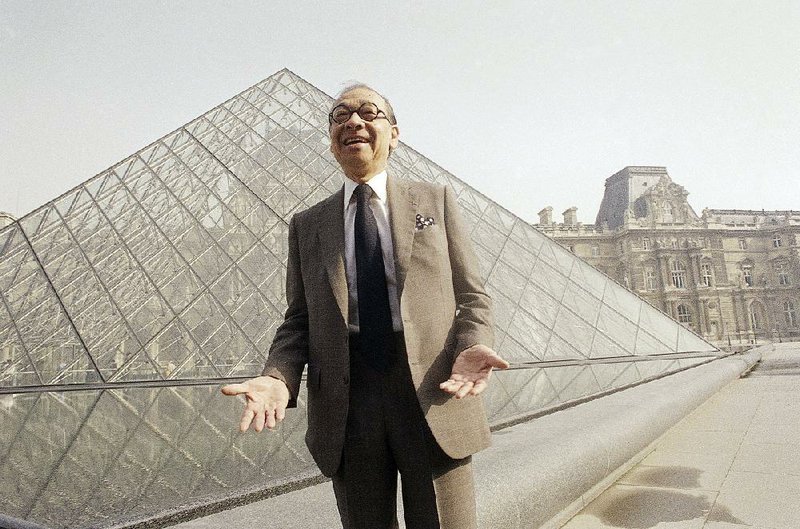I.M. Pei, the Chinese-born American architect who began his long career working for a New York real-estate developer and ended it as one of the most revered architects in the world, has died. He was 102.
His son, Chien Chung Pei, said Thursday that his father had died overnight.
Pei was probably best known for designing the East Building of the National Gallery of Art in Washington and the glass pyramid that serves as an entry for the Louvre in Paris.
Pei gave "this century some of its most beautiful interior spaces and exterior forms," said the jury of the Pritzker Architecture Prize, which Pei won in 1983.
Though reserved and supremely diplomatic, Pei's face, always crowned by round thick-rimmed glasses, could break unexpectedly into a wide, dazzling smile. He approached clients with charm and a quick wit, and they usually succumbed happily.
"Mr. Pei is at once the most pragmatic and the most visionary of architects, his work poised skillfully between the demands of the real world and the dreams of art," Paul Goldberger, architecture critic of The New York Times, wrote in 1989 after the opening of the Louvre pyramid in Paris.
Pei was hired by William Zeckendorf in 1948, shortly after he received his graduate degree in architecture from Harvard, to oversee the design of buildings produced by Zeckendorf's firm, Webb & Knapp.
At a time when most of his Harvard classmates considered themselves fortunate to get to design a single-family house or two, Pei quickly found himself engaged in the design of high-rise buildings, and he used that experience as a springboard to establish his own firm, I.M. Pei & Associates, which he set up in 1955 with Henry Cobb and Eason Leonard, the team he had assembled at Webb & Knapp.
In its early years, I.M. Pei & Associates mainly executed projects for Zeckendorf, including Kips Bay Plaza in New York, finished in 1963; Society Hill Towers in Philadelphia (1964); and Silver Towers in New York (1967). All were notable for their gridded concrete facades.
The firm became fully independent from Webb & Knapp in 1960, by which time Pei, a cultivated man whose quiet, understated manner and easy charm masked an intense, competitive ambition, was winning commissions for major projects that had nothing to do with Zeckendorf. Among these were the National Center for Atmospheric Research in Boulder, Colo., completed in 1967, and the Everson Museum of Art in Syracuse, N.Y., and the Des Moines Art Center in Iowa, both finished in 1968.
They were the first in a series of museums designed by Pei that would come to include the East Building (1978) and the Louvre pyramid (1989) as well as the Rock and Roll Hall of Fame and Museum in Cleveland, for which he designed what amounted to a huge glass tent in 1995. It was perhaps his most surprising commission.
Pei, not a rock 'n' roll fan, initially turned down that job. After he changed his mind, he prepared for the challenge of expressing the spirit of the music by traveling to rock concerts with Jann Wenner, the publisher of Rolling Stone magazine.
The Cleveland project would not be Pei's last unlikely museum commission: His museum oeuvre would culminate in the call to design the Museum of Islamic Art, in Doha, Qatar, of 2008, a challenge that Pei, a longtime collector of Western abstract expressionist art who admitted to knowing little about Islamic art, accepted with relish.
As with the Rock and Roll Hall, he saw it as an opportunity to learn about a part of culture he did not claim to understand. He began his research by reading a biography of the Prophet Muhammad, and then commenced a tour of great Islamic architecture around the world.
Among his many honors were the American Institute of Architects' Gold Medal in 1979; the Grande Medaille d'Or from the Academie d'Architecture de France three years later; and the Presidential Medal of Freedom, the highest civilian honor in the U.S., from President George H.W. Bush in 1992.
Ieoh Ming Pei was born in Canton, China (now Guangzhou), on April 26, 1917, the son of a bank manager. His family later moved to Suzhou, a city near Shanghai. As a young boy, Pei was enthralled by construction of high-rise buildings in Shanghai and Hong Kong.
He came to the U.S. to study architecture at age 17, receiving a bachelor's degree from the Massachusetts Institute of Technology in 1940 and a master's from Harvard University's Graduate School of Design in 1946. At Harvard, he studied with Walter Gropius, one of the masters of modern architecture.
Information for this story was contributed by James S. Russell of Bloomberg News.
A Section on 05/17/2019
